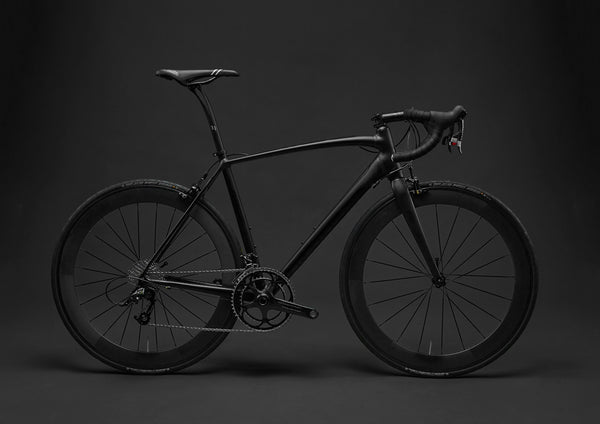Choosing the right bike size for you is the most important decision you can make when buying a bike. But answering the question of what bike size should you get is not always straightforward. And as you age or improve your fitness level, the answer can often change as well.
At Wrench Science we have the specially developed Bike Fit System to help you decide what size frame will work for you, but there are additional methods to find out what frame size and type of bike you should be riding.
Bike size according to height
The most obvious metric to use to decide what size of bike you need is your own height. How tall you are will immediately help narrow down the options. If you are 6’4”, then you are not going to be looking at a small or mid-sized bike. Similarly, if you are 5 '2 " you’ll need to focus on the manufacturers who produce quality smaller frames.
Once you have established that, then you need to start measuring things like your inseam and arm length. How tall you are is one thing, but accurately measuring your leg length, torso and arm length will be the most important factors to help you find the perfect sized bike for your needs.
When you do measure yourself, it’s best to have a friend there to help you, otherwise you risk getting faulty measurements if you try doing it alone. Whether you are measuring to input your numbers to our Fit System, or are gathering your details to start the process of deciding which bike you want, you will require a few very simple tools: a tape measure, a pen, and a level or hardback book, in addition to a buddy to help you.
To measure your height, stand straight against a wall. Have your friend place the level or book on your head against the wall, and mark the wall with a pencil so it's level with the top of your head. Then measure from the ground up to the mark.
Similarly, with the inseam measurement, you will need to stand against a wall and hold the book or level in between your legs snug up against your groin. Make certain it is flat and level against the wall. Have your friend mark the wall with the pencil to make sure the mark accurately reflects your inseam length. If you do it yourself, you are apt to make the mark too low on the wall, as a result of you having to lean over to reach it. Measure the height from the pencil mark to the floor.
Measuring your arm length will also provide an important indicator for what sized bike you should be selecting. Stretch your arm straight out to your side, hold a pen in your fist with the pen pointing down, and then have your friend measure the length from your armpit at the top of the rib cage to the pen.
When you are using our Fit System, we recommend that you take all measurements twice and then use the average. There are several other measurements you can take to finetune exactly how you want your new bike to fit, such as how wide the handlebars need to be, stem length, and crank arm length, but for a basic understanding of what size bike will work best for you, these are the essential measurements to keep in mind.
Types of bikes
Having your measurements is the first step. Knowing what type of bike and style of riding you want to do is the next. Road bikes, racing bikes, and gravel bikes may look very similar, but each will have slightly different geometries to cater to the type of riding each bike is designed to do.
Check out our bike geometry guide to understand the various nuances you will want to be aware of when deciding what bike is right for you.
When looking at a brand’s bike sizing, the size number you are usually looking at is the seat tube length. This measurement is normally from the center of the bottom bracket, though it is far from a standardized system – which is typical for the cycling industry.
Though mountain bikes are also measured from the center of the bottom bracket to the top of the seat tube, how you interpret that number can be slightly different compared to a road or gravel bike. That’s because a mountain bike’s top tube is often much more dramatically sloped to offer a greater amount of standover height, and because mountain bikes frequently will be available in a smaller number of sizes than a road or gravel bike. With many brands offering simply Small, Medium, and Large size options in mountain bikes, deciding on your riding style and types of terrain will factor greatly into the size of mountain bike you will need.
How to measure bike size - Flexibility (and age)
One thing to keep in mind when trying to decide on the right bike size for you is that the answer might change as your fitness improves, as your flexibility improves, or potentially declines. In particular, as we age, we sometimes find that more aggressive riding positions or bike geometries are no longer as comfortable as they once had been. Some of this is down to loss of flexibility, and some of it might be due to a change in riding focus: when once we might have been committed to riding and racing aggressively, we may later in life feel a bit more inclined to take it easier and enjoy the scenery more.
Buying bikes that have some room for adjustment – such as the ability to change out stem lengths – will future-proof you for later tweaks you may want to make to your position. Perhaps if you are just starting out and looking for your preferred riding position, you may feel the benefit of later getting more aggressive in your setup. Alternatively, you may start to move away from any level of competitive desire and want to focus more on comfort, which could change your ideal position as well.
These types of adjustments are totally natural and normal. The whole goal of cycling is to enjoy it as much as you can however you like to ride. Working on your flexibility will benefit you especially if you are intent on staying as aero and aggressive on the bike as possible. You can visit our Fit System if you want to find out how to measure your flexibility, and what impact that measurement will make on the size of bike you should ultimately choose.
What bike size should you choose - Conclusion
When you ask what bike size you should get, it’s important to understand that there are many factors beyond how tall you are that you will need to measure. You will also want to address what style of riding you want to do and how focused on competition or comfort you will most likely be. Our experts at Wrench Science are always ready to speak with you if you’d like to have someone help to talk through the options.



































































































































































































































































